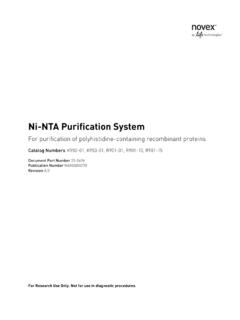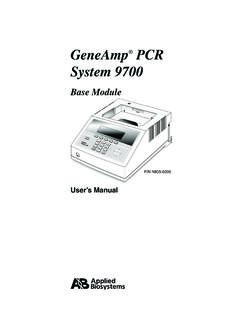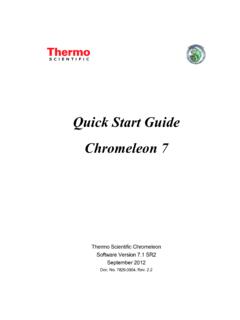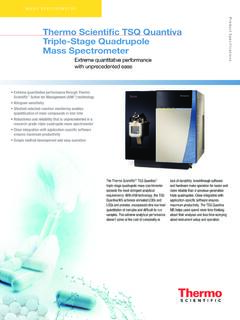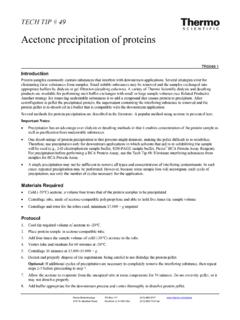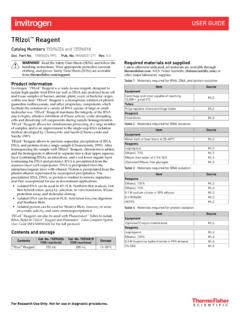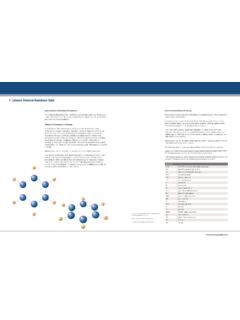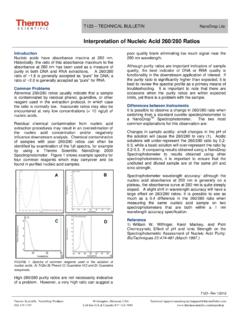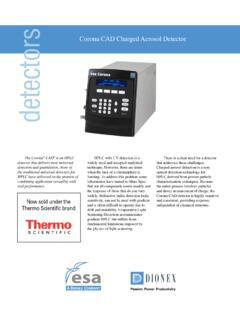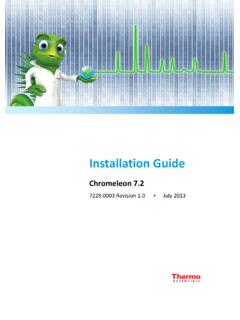Transcription of alamarBlue TI read only - Thermo Fisher Scientific
1 alamarBlue Assay Patent No. 5,501,959. Indications for Use The alamarBlue Assay is designed to measure quantitatively the proliferation of various human and animal cell lines, bacteria and fungi. The bioassay may also be used to establish relative cytotoxicity of agents within various chemical classes (3). The toxicologist can establish baseline data for predicting the toxicity of related novel agents by comparing such baseline data with known in-vivo toxicity. The assay is simple to perform since the indicator is water soluble, thus eliminating the washing/fixing and extraction steps required in other commonly used cell proliferation assays. Product Description The alamarBlue Assay incorporates a fluorometric/colorimetric growth indicator based on detection of metabolic activity. Specifically, the system incorporates an oxidation-reduction (REDOX) indicator that both fluoresces and changes color in response to chemical reduction of growth medium resulting from cell growth (6).
2 The specific (fluorometric/colorimetric) REDOX indicator incorporated into alamarBlue has been carefully selected because of several properties. First, the REDOX indicator exhibits both fluorescence and colorimetric change in the appropriate oxidation-reduction range relating to cellular metabolic reduction. Second, the REDOX indicator is demonstrated to be minimally toxic to living cells. Third, the REDOX indicator produces a clear, stable distinct change which is easy to interpret. The REDOX indicator has no current or past indication of carcinogenic capacity. As cells being tested grow, innate metabolic activity results in a chemical reduction of alamarBlue . Continued growth maintains a reduced environment while inhibition of growth maintains an oxidized environment. Reduction related to growth causes the REDOX indicator to change from oxidized (non-fluorescent, blue) form to reduced (fluorescent, red) form. Experiments performed at Alamar suggest that reduction of alamarBlue requires uptake by the cells.
3 To test this hypothesis, we grew A549 cells to confluency in T25 flasks using RPMI 1640. The media was then removed from two flasks containing cells and replaced with fresh media. Fresh media was also added to a sterile flask containing no cells to serve as a negative control. All flasks were then re-incubated at 37 C, 5% CO2 for four hours. At the end of the four hour incubation, alamarBlue was added to each flask. There was no immediate color change in any flasks upon addition. In one of the flasks containing cells, the media was left in contact with the cell layer, while the other T flask was turned over so that the media was not in contact with the cell layer. All flasks were then incubated for 1 hour at 37 and rechecked for color change. If alamarBlue reduction occurred simply from the reduction of the external medium, we would expect the flask in which the media was in contact with the cells and the flask in which media was no longer in contact with the cells to exhibit the same amount of reduction.
4 This was not the case. The flask where the media was not in contact with the monolayer following addition of alamarBlue displayed no color change from the blue of the negative control flask. The flask Page 1 of 27. where the cells were in contact with the monolayer was very pink, indicating a higher percentage of reduction. This seems to indicate uptake by the cells is required for reduction of alamarBlue . We have analyzed the possible interaction of alamarBlue in cellular respiration by looking at the relative redox potential of the various components of the biological respiration chain. These are presented in Table 1, which includes the oxidation reduction potentials for alamarBlue and MTT. and where they interact with the system. Table 1. Oxidation reduction potentials in the electron-transport system. Half-reaction E1o(mV) 25 C. O2 + 4H+ + 4e- 2H2O +820. alamarBlue ox + 2H + 2e- alamarBlue RED +380. cytochromesox + 1e- cytochromesRED +290 to +80.
5 MTTox + 2H+ + 2e- MTTRED -110. FMN + 2H+ + 2e- FMNH2 -210. FAD + 2H+ + 2e- FADH2 -220. NAD + 2H+ + 2e- NADH + H+ -320. NADP + 2H+ + 2e- NADPH + H+ -320. A substance on the left side of one of the half reactions can be expected to oxidize a substance on the right side only if the latter has a more negative E0 than the former. Using this rule, it is evident that MTT will be reduced by FMNH2, FADHs, NADH, NADPH, but will not be reduced by cytochromes. It is further evident that alamarBlue will be reduced not only be each of these, but by the cytochromes as well. The importance of this lies in the fact that the flow of electrons may be interrupted by the introduction of an artificial electron-acceptor (redox indicator) with an oxidation-reduction potential intermediate between those of any two members of the electron transport chain. Thus, whenever a substrate is oxidized in the presence of a tetrazolium salt (MTT), the released electrons will not be transported through the usual sequence of cytochromes, but will be trapped.
6 This shuts down the respiratory chain. alamarBlue , on the other hand, is intermediate only between final reduction of O2 and cytochrome oxidase ( ). alamarBlue is reduced by the removal of oxygen and its replacement by hydrogen. alamarBlue may substitute for molecular oxygen for any of the oxidoreductases which routinely utilize molecular oxygen as an electron acceptor. Data may be collected using either fluorescence based or absorbance based instrumentation. Fluorescence is monitored at 530-560nm excitation wavelength and 590nm emission wavelength (Fig. 1a). Absorbance is monitored at 570nm and 600nm (Figure 1b). Page 2 of 27. 5000. 4000. FLUORESCENCE. Oxidized (590nm). 3000. Reduced (590nm). 2000. 1000. 0. 400 450 500 550 600 650 700. WAVELENGTH (nm). Figure 1a. alamarBlue Fluorescence Emission Spectra ABSORBANCE. Oxidized (600nm). Reduced (570nm). 0. 400 450 500 550 600 650 700. WAVELENGTH (nm). Figure 1b. alamarBlue Absorbance Page 3 of 27. Advantages The alamarBlue Assay offers many advantages over conventional cell or radioactively-labelled incorporation assays: Features Benefits Fluorescent/Colorimetric Allows Choice of detection method Water soluble No extraction required Works on suspension or No centrifugation required attached cell lines Fewer steps Time saving/easily adaptable to automation Stable Allows for continuous cell Growth monitoring, kinetic Studies, incubation time of days Non-toxic to cells Less likely to interfere with Normal metabolism Non-toxic to technician Safe, disposable, less regulation Page 4 of 27.
7 Storage Conditions alamarBlue should be stored in the dark, since the compound is light sensitive (Table 2). The product may be stored for 12 months at room temperature. This expiration date is given on the product label. If shelf life beyond 12 months is desired, storage at 2-8 C increases shelf life to 20. months. alamarBlue may also be frozen at -70 C indefinitely. Because the indicator is a multicomponent solution, it is recommended that frozen alamarBlue be warmed to 37 C and shaken to ensure all components are completely in solution. Table 2. alamarBlue Stability Average absorbance at 600 nm is presented for each month tested. alamarBlue was packaged in amber bottles. Light exposure was continuous at a level of approximately 100 lumens. Measurements were made on a Perkin Elmer UV/VIS Spectrophotometer Lamda 2 model with a 1 cm path length. MONTH. Storage Condition 0 1 2 3 4 5 6 10 12. Room Temp Light Room Temp Dark 1. ABSORBANCE. Room Temp Light Room Temp Dark 0 5 10 15.
8 MONTHS IN STORAGE. Page 5 of 27. Quality Control Testing Method for alamarBlue . Materials and Equipment: pH , potassium phosphate buffer 10 ml test tube pipettor capable of accurately dispensing ml plate reader with one of the following filters: 540, 570, 600, 630nm Dynatech flat bottom plate Procedure 1. Pipette ml of alamarBlue into a test tube. 2. Dilute to 10 mls with phosphate buffer. 3. Mix well. 4. Pipette 100 l into each well of a clear, flatbottom microblate (note: there will be enough solution to fill 10 columns in the plate). 5. Read absorbance at appropriate wavelenths. *Expected Results: Wavelength (nm) Average Absorbance (Standard Deviation). 540 ( ). 570 ( ). 600 ( ). 630 ( ). *Absorbance Values may be affected by the type of plate (whether round or flat bottom). and the plate manufacturer. The reduced form (red) of alamarBlue is very unstable in water. For this reason, it is difficult to recommend a standard test for the reduced form.
9 However, the reduced form is very stable in media. To determine the absorbance/fluorescence to be expected from the reduced form (red). for a particular experiment, it is suggested that 1X alamarBlue be made up in the media intended for use in an autoclavable container. Reduce this preparation by autoclaving for 15 minutes. Remove from the autoclave and allow to cool to room temperature. Swirl the solution several times and pipette 100 l into the wells of a flat bottom microtiter plate. Measure the absorbance at the proper wavelenths. Table 3 a-b presents the absorbance values for the oxidized and reduced forms of the indicator in several commonly used culture media. No QC protocol is recommended for fluorescence since fluorescence units are arbitrary and the scale used varies widely from one instrument to another. From table 3 a-b it should be apparent that the reduced form of alamarBlue is highly fluorescent. When attempting to measure very small changes in reduction, fluorescence measurements will produce greater sensititvity.
10 Page 6 of 27. Table 3a-b. Absorbance values for oxidized/reduced forms of alamarBlue for commonly used culture media. Powdered media was obtained from Sigma and prepared according to their instructions. All media contained phenol red. The required amount of sodium bicarbonate was added to each media, and each was pH adjusted to with 1N HCl or 1N NaOH. alamarBlue was added to each media which was then split into 2 samples. One sample of each media was autoclaved for 15 minutes to produce the reduced form. The medias were dispensed into a flat bottom Dynatech plate (100 l per well) and absorbance read at 540, 570, 600, 630nm on a Cambridge Technologies plate reader. Fluorescence measurements were made on a Cambridge Technologies, Inc. (Watertown, MA) Model 7620 Microplate fluorometer settings were: bottom reading, light source setting 12, no max AFU, excitation: 530, emission: 560, gain/16. a. ABSORBANCE VALUES. Wavelength (nm). Powdered Sigma 540 570 600 630.
